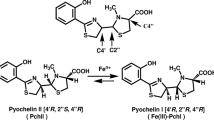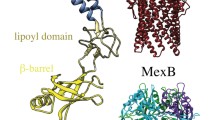Abstract
Pseudomonas aeruginosa is an important nosocomial human pathogen. The major difficulty in the fight against this pathogen is the relative impermeability of its outer membrane (OM). Only specific substrates can penetrate through the OM of P. aeruginosa via substrate-specific porins, so this has become one of the most problematic drug-resistant pathogens. Carbapenems are the most effective drugs for treating P. aeruginosa infections. One such carbapenem that is applied in cases of P. aeruginosa infection is imipenem (IMI), which uses outer membrane carboxylate channel D1 (OccD1) as a point of entry into the pathogen. Unlike IMI, ertapenem (ERTA, another carbapenem) shows only weak activity towards P. aeruginosa, as it is blocked from penetrating through the OM. However, it is currently unclear as to why IMI is allowed to pass through the OM while ERTA is not. Therefore, we conducted molecular dynamics (MD) simulations to elucidate the behavior of these drugs inside OccD1 as compared to the ligand-free state. We discovered another possible binding site in the constriction region close to the side-pore opening. Both drugs employ the core lactam part to tether themselves to the binding site, whereas the tail governs the direction of permeation. L132 and F133 appear to be involved in interactions that are key to core attachment. At least four hydrogen bonds are required for drug binding. The direction of motion of L2 also plays a role: inward flipping traps IMI in the constriction area, while a shift of L2 towards the membrane brings ERTA into contact with more water, which prompts the expulsion of ERTA to the mouth of the channel protein. The opening of L2 seems to facilitate the rejection of ERTA.





Similar content being viewed by others
Abbreviations
- MD:
-
Molecular dynamics
- OccD1:
-
Outer membrane carboxylate channel D1
- OMP:
-
Outer-membrane protein
- IMI:
-
Imipenem
- ERTA:
-
Ertapenem
References
Nikaido H (2003) Molecular basis of bacterial outer membrane permeability revisited. Microbiol Mol Biol Rev 67:593–656
Malek K, Maghari A (2007) Translocation and interactions of L-arabinose in OmpF porin: a molecular dynamics study. Biochem Biophys Res Commun 352(1):104–110. doi:10.1016/j.bbrc.2006.10.183
Galdiero S, Falanga A, Cantisani M, Tarallo R, Della Pepa ME, D’Oriano V, Galdiero M (2012) Microbe–host interactions: structure and role of Gram-negative bacterial porins. Curr Protein Pept Sci 13(8):843–854
Nestorovich EM, Rostovtseva TK, Bezrukov SM (2003) Residue ionization and ion transport through OmpF channels. Biophys J 85(6):3718–3729. doi:10.1016/S0006-3495(03)74788-2
Basle A, Qutub R, Mehrazin M, Wibbenmeyer J, Delcour AH (2004) Deletions of single extracellular loops affect pH sensitivity, but not voltage dependence, of the Escherichia coli porin OmpF. Protein Eng Des Sel 17(9):665–672. doi:10.1093/protein/gzh078
Todt JC, Rocque WJ, Mcgroarty EJ (1992) Effects of Ph on bacterial porin function. Biochemistry 31(43):10471–10478
Kojima S, Nikaido H (2013) Permeation rates of penicillins indicate that Escherichia coli porins function principally as nonspecific channels. Proc Natl Acad Sci USA 110(28):E2629–E2634. doi:10.1073/pnas.1310333110
Naveed H, Jimenez-Morales D, Tian J, Pasupuleti V, Kenney LJ, Liang J (2012) Engineered oligomerization state of OmpF protein through computational design decouples oligomer dissociation from unfolding. J Mol Biol 419(1–2):89–101. doi:10.1016/j.jmb.2012.02.043
Moraes TF, Bains M, Hancock RE, Strynadka NC (2007) An arginine ladder in OprP mediates phosphate-specific transfer across the outer membrane. Nat Struct Mol Biol 14(1):85–87
Eren E, Parkin J, Adelanwa A, Cheneke B, Movileanu L, Khalid S, van den Berg B (2013) Toward understanding the outer membrane uptake of small molecules by Pseudomonas aeruginosa. J Biol Chem 288(17):12042–12053. doi:10.1074/jbc.M113.463570
Isabella VM, Campbell AJ, Manchester J, Sylvester M, Nayar AS, Ferguson KE, Tommasi R, Miller AA (2015) Toward the rational design of carbapenem uptake in Pseudomonas aeruginosa. Chem Biol 22(4):535–547. doi:10.1016/j.chembiol.2015.03.018
Shen J, Pan Y, Fang Y (2015) Role of the outer membrane protein OprD2 in carbapenem-resistance mechanisms of Pseudomonas aeruginosa. PLoS One 10(10):e0139995. doi:10.1371/journal.pone.0139995
Biswas S, Mohammad MM, Patel DR, Movileanu L, van den Berg B (2007) Structural insight into OprD substrate specificity. Nat Struct Mol Biol 14(11):1108–1109. doi:10.1038/Nsmb1304
Biswas S, Mohammad MM, Movileanu L, van den Berg B (2008) Crystal structure of the outer membrane protein OpdK from Pseudomonas aeruginosa. Structure 16(7):1027–1035. doi:10.1016/j.str.2008.04.009
Eren E, Vijayaraghavan J, Liu JM, Cheneke BR, Touw DS, Lepore BW, Indic M, Movileanu L, van den Berg B (2012) Substrate specificity within a family of outer membrane carboxylate channels. PLoS Biol 10(1). doi: 10.1371/Journal.Pbio.1001242
Parkin J, Khalid S (2014) Atomistic molecular-dynamics simulations enable prediction of the arginine permeation pathway through OccD1/OprD from Pseudomonas aeruginosa. Biophys J 107(8):1853–1861. doi:10.1016/j.bpj.2014.08.035
Livermore DM, Mushtaq S, Warner M (2005) Selectivity of ertapenem for Pseudomonas aeruginosa mutants cross-resistant to other carbapenems. J Antimicrob Chemother 55(3):306–311. doi:10.1093/jac/dki009
Quale J, Bratu S, Gupta J, Landman D (2006) Interplay of efflux system, ampC, and oprD expression in carbapenem resistance of Pseudomonas aeruginosa clinical isolates. Antimicrob Agents Chemother 50(5):1633–1641. doi:10.1128/Aac.50.5.1633-1641.2006
Tieleman DP, Berendsen HJ (1998) A molecular dynamics study of the pores formed by Escherichia coli OmpF porin in a fully hydrated palmitoyloleoylphosphatidylcholine bilayer. Biophys J 74(6):2786–2801. doi:10.1016/S0006-3495(98)77986-X
Pongprayoon P (2014) How do the protonation states of E296 and D312 in OmpF and D299 and D315 in homologous OmpC affect protein structure and dynamics? Simulation studies. Comput Biol Chem 53PB:226–234. doi:10.1016/j.compbiolchem.2014.10.006
Niramitranon J, Sansom MS, Pongprayoon P (2016) Why do the outer membrane proteins OmpF from E. coli and OprP from P. aeruginosa prefer trimer? Simulation studies. J Mol Graph Model 65:1–7. doi:10.1016/j.jmgm.2016.02.002
Kumar A, Hajjar E, Ruggerone P, Ceccarelli M (2010) Structural and dynamical properties of the porins OmpF and OmpC: insights from molecular simulations. J Phys Condens Matter 22(45). doi:10.1088/0953-8984/22/45/454125
Singh PR, Ceccarelli M, Lovelle M, Winterhalter M, Mahendran KR (2013) Antibiotic permeation across the OmpF channel: modulation of the affinity site in the presence of magnesium. J Phys Chem B 116(15):4433–4438. doi:10.1021/jp2123136
Ziervogel BK, Roux B (2013) The binding of antibiotics in OmpF porin. Structure 21(1):76–87. doi:10.1016/j.str.2012.10.014
Mahendran KR, Hajjar E, Mach T, Lovelle M, Kumar A, Sousa I, Spiga E, Weingart H, Gameiro P, Winterhalter M, Ceccarelli M (2010) Molecular basis of enrofloxacin translocation through OmpF, an outer membrane channel of Escherichia coli—when binding does not imply translocation. J Phys Chem B 114(15):5170–5179. doi:10.1021/Jp911485k
Faraldo-Gomez JD, Smith GR, Sansom MS (2002) Setting up and optimization of membrane protein simulations. Eur Biophys J 31(3):217–227
Schuttelkopf AW, van Aalten DM (2004) PRODRG: a tool for high-throughput crystallography of protein–ligand complexes. Acta Crystallogr D 60(Pt 8):1355–1363. doi:10.1107/S0907444904011679
Goodsell DS, Morris GM, Olson AJ (1996) Automated docking of flexible ligands: applications of AutoDock. J Mol Recognit 9(1):1–5. doi:10.1002/(SICI)1099-1352(199601)9:1<1::AID-JMR241>3.0.CO;2-6
Lindahl E, Hess B, van der Spoel D (2001) GROMACS 3.0: a package for molecular simulation and trajectory analysis. J Mol Model 7:306–317
Darden T, York D, Pedersen L (1993) Particle mesh Ewald: an N·log(N) method for Ewald sums in large systems. J Chem Phys 98(12):10089–10092
Berendsen HJC, Postma JPM, van Gunsteren WF, DiNola A, Haak JR (1984) Molecular dynamics with coupling to an external bath. J Chem Phys 81(8):3684–3690
Humphrey W, Dalke A, Schulten K (1996) VMD—Visual Molecular Dynamics. J Mol Graph 14:33–38
Ochs MM, Bains M, Hancock REW (2000) Role of putative loops 2 and 3 in imipenem passage through the specific porin OprD of Pseudomonas aeruginosa. Antimicrob Agents Chemother 44(7):1983–1985
Li H, Luo YF, Williams BJ, Blackwell TS, Xie CM (2012) Structure and function of OprD protein in Pseudomonas aeruginosa: from antibiotic resistance to novel therapies. Int J Med Microbiol 302(2):63–68. doi:10.1016/j.ijmm.2011.10.001
Acknowledgements
We would like to thank the Thailand Research Fund (code: TRG5880230) and Kasetsart University Research and Development Institute (KURDI) for their financial support of this work. We also thank Prof. Supa Hannongbua.
Author information
Authors and Affiliations
Corresponding author
Electronic supplementary material
ESM 1
(DOCX 533 kb)
Rights and permissions
About this article
Cite this article
Somboon, K., Niramitranon, J. & Pongprayoon, P. Probing the binding affinities of imipenem and ertapenem for outer membrane carboxylate channel D1 (OccD1) from P. aeruginosa: simulation studies. J Mol Model 23, 227 (2017). https://doi.org/10.1007/s00894-017-3400-2
Received:
Accepted:
Published:
DOI: https://doi.org/10.1007/s00894-017-3400-2




